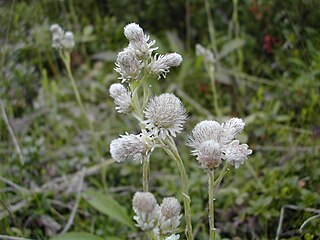
Antennaria alpina is a European and North American species of plant in the family Asteraceae. Antennaria alpina is native to mountainous and subarctic regions of Scandinavia, Greenland, Alaska, and the Canadian Arctic, extending south at high altitudes in mountains in the Rocky Mountains south to Montana and Wyoming.

Silene flos-cuculi, commonly called ragged-robin, is a perennial herbaceous plant in the family Caryophyllaceae. It is native to Eurasia and has been introduced to North America.

Silene dioica, known as red campion and red catchfly, is a herbaceous flowering plant in the family Caryophyllaceae, native to Europe and introduced to the Americas.

Betula pumila is a deciduous shrub native to North America. Bog birch occurs over a vast area of northern North America, from Yukon in the west to New England in the east and all the way to Washington and Oregon, inhabiting swamps and riparian zones in the boreal forests.

Balsamorhiza sagittata is a North American species of flowering plant in the tribe Heliantheae of the family Asteraceae known by the common name arrowleaf balsamroot. Also sometimes called Oregon sunflower, it is widespread across western Canada and much of the western United States.
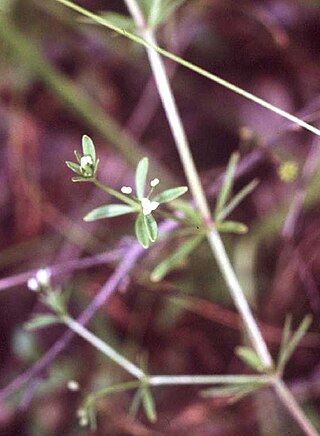
Galium trifidum is a species of flowering plant in the coffee family, known by the common name three-petal bedstraw. It grows widespread in the arctic, temperate and subtropical regions of the Northern Hemisphere: northern and central Asia, northern and eastern Europe and much of North America.

Sedum lanceolatum is a species of flowering plant in the family Crassulaceae known by the common names spearleaf stonecrop and lanceleaf stonecrop.
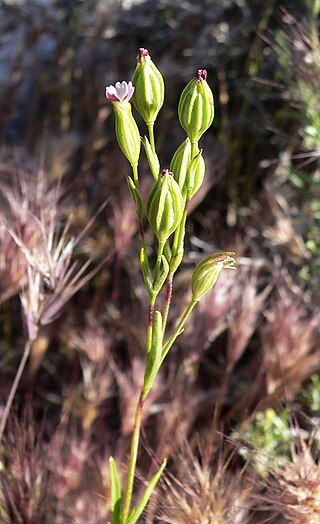
Silene antirrhina is a species of flowering plant in the family Caryophyllaceae known by the common names sleepy silene and sleepy catchfly. It is native to the Americas and has been introduced to Europe.
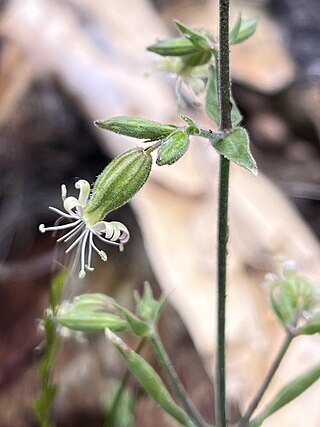
Silene bridgesii is a species of flowering plant in the family Caryophyllaceae known by the common name Bridges' catchfly.
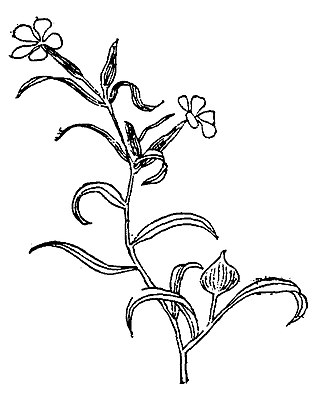
Silene conoidea is a species of flowering plant in the family Caryophyllaceae known by the common names weed silene and large sand catchfly. It is native to Eurasia, and it is known in other parts of the world, such as western North America, as a weed.

Silene douglasii is a species of flowering plant in the family Caryophyllaceae known by the common name Douglas's catchfly.

Silene gallica is a species of flowering plant in the family Caryophyllaceae known by several common names, including common catchfly, small-flowered catchfly, and windmill pink. It is native to Eurasia and North Africa, but it can be found throughout much of the temperate world as a common roadside weed.
Silene salmonacea is a rare, newly described species of flowering plant in the family Caryophyllaceae known by the common names Klamath Mountain catchfly and salmon-flowered catchfly. It is known only from Trinity County, California, where it grows in the forests of the southern Klamath Mountains. It is a member of the serpentine soils flora. It is a small perennial herb growing just a few centimeters tall. The spoon-shaped leaves are up to 3.5 centimeters long. The herbage is gray-green and lightly woolly in texture. Each flower has a tubular calyx of fused sepals lined with ten veins. There are five salmon pink petals, each with four lobes at the tip.
Silene marmorensis is a rare species of flowering plant in the family Caryophyllaceae known by the common names Marble Mountain catchfly, Marble Mountain campion, and Somes Bar campion. It is endemic to the southern Klamath Mountains of northern California, where it grows in mountain woodlands and forests. It is a perennial herb producing several stems and shoots from a woody, branching caudex and thick taproot. The hairy, glandular stems grow erect to a maximum height near 40 centimeters. The lance-shaped leaves are a few centimeters long and are borne in pairs, the lowermost drying early. The inflorescence is a terminal cyme of flowers at the top of the stem, and some flowers may occur in the leaf axils. Each flower has a hairy, veined calyx of fused sepals. The flowers bloom at night, the five pinkish or green-tinged petals opening at the tip of the calyx.

Silene multinervia is a species of flowering plant in the family Caryophyllaceae known by the common name manynerve catchfly.

Silene noctiflora is a species of flowering plant in the family Caryophyllaceae known by the common names night-flowering catchfly, nightflowering silene and clammy cockle. It is native to Eurasia, but it is known on other continents as an introduced species and sometimes a weed. In North America, it is a common weed of grain crops in the Canadian prairie provinces and in much of the United States. It grows in fields and in other disturbed habitat.

Silene scouleri is a species of flowering plant in the family Caryophyllaceae known by the common names simple campion and Scouler's catchfly.

Silene spaldingii is a rare species of flowering plant in the family Caryophyllaceae known by the common names Spalding's silene, Spalding's catchfly and Spalding's campion. It is native to eastern Washington, eastern Oregon, northern Idaho and northern Montana, where its distribution extends just into British Columbia, Canada. Much of its former habitat has been converted to agriculture and its range is now limited to the last remaining stretches of pristine prairie grassland in this region. It is threatened by the degradation and loss of its remaining habitat. It is federally listed as a threatened species in the United States and it is designated endangered by Canada's COSEWIC.

Lupinus arcticus is a species of flowering plant in the legume family known by the common names Arctic lupine or subalpine lupine. It is native to northwestern North America, where it occurs from Oregon north to Alaska and east to Nunavut. It is a common wildflower in British Columbia.

Salix commutata, the undergreen willow, is a plant species native to western Canada and the north-western United States. It has been reported from Alaska, Yukon, the Northwest Territories, British Columbia, Alberta, Saskatchewan, Montana, Idaho. Washington and Oregon. It grows on rocky alpine and subalpine slopes, conifer forests, stream banks, bogs, etc.

















